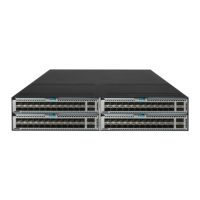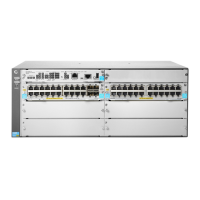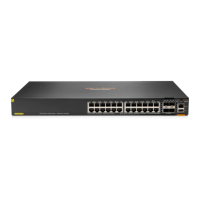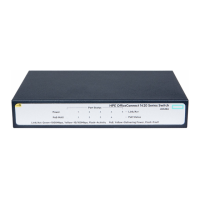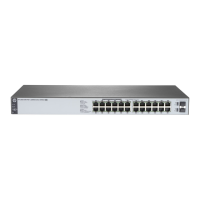56
Step Command Remarks
2. Enter aggregate interface
view.
• Enter Layer 2 aggregate
interface view:
interface
bridge-aggregation
interface-number
• Enter Layer 3 aggregate
interface view:
interface
route-aggregation
interface-number
N/A
3. Configure the aggregate
interface as an edge
aggregate interface.
lacp edge-port
By default, an aggregate interface
does not operate as an edge
aggregate interface.
Enabling BFD for an aggregation group
BFD for Ethernet link aggregation can monitor member link status in an aggregation group. After you
enable BFD on an aggregate interface, each Selected port in the aggregation group establishes a
BFD session with its peer port. BFD operates differently depending on the aggregation mode.
• BFD for static aggregation—When BFD detects a link failure, BFD notifies the Ethernet link
aggregation module that the peer port is unreachable. The local port is placed in Unselected
state. The BFD session between the local and peer ports remains, and the local port keeps
sending BFD packets. When the link is recovered, the local port receives BFD packets from the
peer port, and BFD notifies the Ethernet link aggregation module that the peer port is reachable.
The local port is placed in Selected state again. This mechanism ensures that the local and
peer ports of a static aggregate link have the same aggregation state.
• BFD for dynamic aggregation—When BFD detects a link failure, BFD notifies the Ethernet
link aggregation module that the peer port is unreachable. BFD clears the session and stops
sending BFD packets. When the link is recovered and the local port is placed in Selected state
again, the local port establishes a new session with the peer port. BFD notifies the Ethernet link
aggregation module that the peer port is reachable. Because BFD provides fast failure
detection, the local and peer systems of a dynamic aggregate link can negotiate the
aggregation state of their member ports faster.
For more information about BFD, see High Availability Configuration Guide.
Configuration restrictions and guidelines
When you enable BFD for an aggregation group, follow these restrictions and guidelines:
• Make sure the source and destination IP addresses are consistent at the two ends of an
aggregate link. For example, if you execute link-aggregation bfd ipv4 source 1.1.1.1
destination 2.2.2.2 on the local end, execute link-aggregation bfd ipv4 source 2.2.2.2
destination 1.1.1.1 on the peer end. The source and destination IP addresses cannot be the
same.
• The BFD parameters configured on an aggregate interface take effect on all BFD sessions in
the aggregation group. BFD sessions for link aggregation do not support the echo packet mode
and the Demand mode.
• As a best practice, do not configure other protocols to collaborate with BFD on a BFD-enabled
aggregate interface.
• Make sure the number of member ports in a BFD-enabled aggregation group is not larger than
the number of BFD sessions supported by the device. Otherwise, this command might cause
some Selected ports in the aggregation group to change to the Unselected state.

